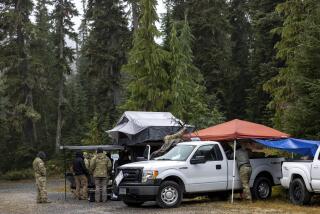First U.S. Woman Fighter Pilot Ready to Take Wing : Lt. Jeannie Flynn bided her time in flight instructor’s course until the Air Force’s combat ban was lifted. Now she will fly the F-15E.
- Share via
WASHINGTON — Air Force Lt. Jeannie Flynn had never been one to buck the system.
Even though she had graduated first in her pilot training class early last year, she knew the Air Force would turn down her request to fly its top fighter plane. Women were, after all, prohibited from serving in combat.
When the expected denial came, Flynn quietly switched to Plan B and enrolled in a flight instructor course in California, hoping that some day the clouds would lift over her primary target.
Then the phone call came: the Clinton Administration had lifted its ban against women in air combat and the Air Force was offering her the chance to fly its screaming F-15E Strike Eagle.
Now, more than 10 months later, the 27-year-old Flynn has finished her training and will report next month to her unit--the Fourth Wing at Seymour Johnson Air Force Base in North Carolina--as the first woman fighter pilot in U.S. history.
In an acknowledgment that not everyone loves a trailblazer, Flynn said Tuesday: “I realize that not every person wanted this to happen. . . . But I also know that at this time, that’s irrelevant.”
She added that she was excited about reporting to duty as a full-fledged combat pilot, noting: “I’ve been in training for most of my Air Force life so far.”
When the Administration lifted the ban last April and permitted women to join the ranks of fighter pilots, Flynn and 14 other women were chosen to lead the way.
Flynn was ushered almost immediately into Strike Eagle qualification training at Luke Air Force Base in Arizona, while the others began or are scheduled to start training on an array of other combat aircraft.
When she reports to duty after completing a brief survival course, Flynn will find herself in control of an attack plane considered to be the most advanced in the world.
Originally built by McDonnell Douglas in 1972, the Strike Eagles were among the first aircraft that were deployed in the Persian Gulf in August, 1990. They led an attack on Iraqi forces on Jan. 16, 1991.
Able to fly at low altitudes day or night and in bad weather, the planes can fight their way to and from targets and hit them at close or long range with infrared air-to-surface missiles and laser-guided bombs.
Born in St. Louis, Flynn said that becoming a fighter pilot was the unexpected realization of a dream.
“I wanted to fly (a fighter) but I thought the policy would be (in force) for much longer than it was,” she said. “I was looking at other options in case combat wasn’t available to me.”
Her interest in flying began with her first trip on a commercial airliner when she was a senior at Bishop DuBourg High School in St. Louis, where she graduated in the top 1% of her class.
Flynn went on to study aerospace engineering at the University of Texas at Austin, graduating with honors.
While in college, she enrolled in a two-year Reserve Officer Training Corps program that gave her her first taste of flying in a military jet.
“Once I tried that, I was hooked,” Flynn said, explaining that she then began to look at career opportunities that would allow her to fly planes--or perhaps become an astronaut.
Flynn joined the Air Force on active duty in January, 1992, after a yearlong wait to enroll in a pilot training course. During the hiatus, she earned her master’s degree in aeronautics and astronautics at Stanford University, graduating in December, 1991.
Flynn said she has long gotten over the rejection of her first request to fly the Strike Eagle and now looks forward to the challenge.
And she has no worries about facing harassment from her male colleagues, saying she has never faced that problem in the Air Force.
“What really matters is just that you’re qualified and that you’re competent in your job,” she said.
More to Read
Sign up for Essential California
The most important California stories and recommendations in your inbox every morning.
You may occasionally receive promotional content from the Los Angeles Times.











